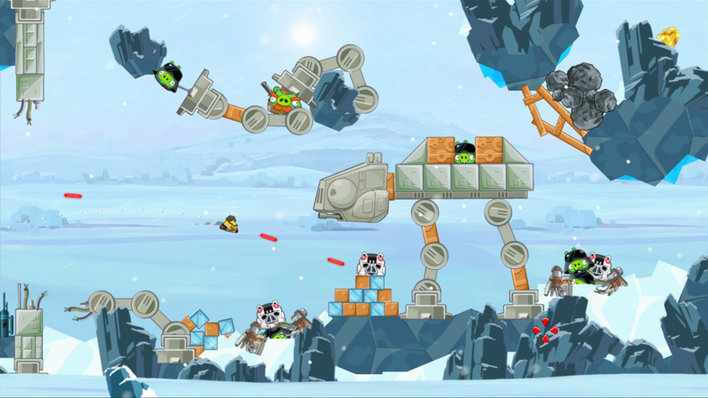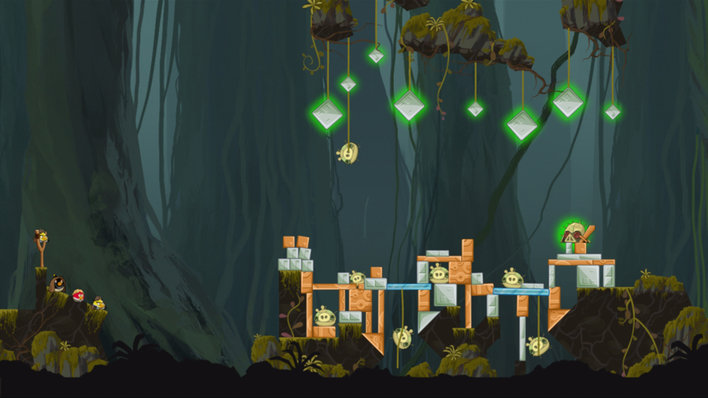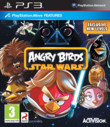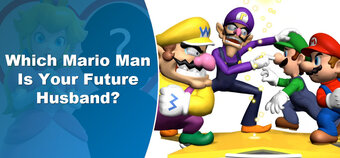Unless you've been living under a rock, in the Outer Hebrides, with only a goat named Phil and a puffin called Steve for companionship (and if you have, you should be writing a treatment now - that sounds like the perfect formula for a sitcom), the chances are you've at least heard of Angry Birds, if not managed to get addicted to it yourself. A tablet sensation that has everyone, from grans to grandchildren alike flinging the cartoon birds at their mortal enemies - the pigs - it's been an incredibly successful hit on the smartphones, but somewhat less so on consoles.
Angry Birds Star Wars is the latest attempt to put that right - fitting 200 levels from the tablet game on to a disc, and releasing it on an unsuspecting public at an RRP of £29.99 (although it can currently be found for £17). The eagle eyed amongst you will have noticed that that's substantially more than the tablet game, which can be played either for free, if you're willing to tolerate the regular adverts, or for £1.99, making the console version almost a 10x mark-up at its current sale price. What do you get for your extra money, you might ask? Well, very little. In fact, you actually seem to get less.
And it's a shame, because Angry Birds Star Wars, for all other intents and purposes is a very good game. Mixing the pick up and play appeal of the angry avians with the sci-fi stylings of Star Wars is a great pairing - and it actually allows the game more freedom.

Some of the later levels feature forts based around Star Wars vehicles, too. Those boulders look a bit precarious in the top right, mind.
To begin with, things seem fairly similar to every other Angry Birds game that's gone before. All you have to do is pull back on the stick to angle your shot, and press X to send your angry bird flying towards the stormtrooper pigs on the other side of the screen, who've gone to great lengths to build an elaborate fort that you're going to be smashing up. Knock it over well enough, and you'll "kill" the pigs, who'll disappear in a puff of smoke - and all you have to do is get rid of them all. Which is easier said than done.
As with any game that relies on physics, there's a fair amount of trial and error here, as the same shot can produce two very different results, depending on how the planks and pillars of the pigs' fort fall. Should you eliminate all the pigs, you'll be given a rating out of three stars depending on how many points you've wracked up - and boy, will you spend a lot of time replaying levels to try and reach that illusive three star rating. Seemingly, there's usually an official "way" of doing it, which lets you complete the level with a single bird, if you hit a particular plank, blow up a box, or otherwise bash into their pile of planks in just the right way. Figuring it out is as much fun as anything, especially with a few friends in tow.
One of the only new features for the console version is the multiplayer mode, which may sound like a great idea on paper, but sadly hasn't really had all that much effort put into it. Letting you play through the entire game in co-op seems like a win-win situation, but in practice, it doesn't really offer anything that you couldn't already do by simply taking it in turns and passing a controller around yourself. Still, perhaps having a structure that decides who's turn it is is a good thing. Meanwhile, a competitive four player mode has also been added, which pits you against three friends in a race to earn the highest score, and at least feels like more of a "mode" than co-op does - but it still doesn't really justify the £20 price tag.

Later on, you'll visit Yoda's haunt of Dagobah, the snowy wasteland of Hoth, and even the Death Star itself.
Whether you're playing in single player or co-op though, Angry Birds is one of those games that gives back the more you put in. While the first few levels are fairly standard fare, when you really start making some progress, the game starts to open out, becoming much more creative in the process. Space levels invoke gravity, to make judging your shots that much trickier (after all, how do you tell if it's a moon or a space station?), along with adding an extra variable into the mix, while crates of TNT, and switches that detonate every explosive on the level offer an enticing target - if only you can figure out how to reach them.
As you'd likely expect, each bird has been given a Star Wars makeover too, with each having its own unique power. The Han Solo bird can fire lasers mid-flight (making it incredibly useful for picking off that out-in-the-distance pig before you go sailing into the others), Obi Wan can use the force to send bricks, pigs, and anything else in range flying, while Luke relies on his trusty lightsaber to slice through pillars, poles and blocks to crash into the delicate central parts of the fort. Figuring out which ability to use where is key to getting a high score, and you'll need some precise timing to get it right - even if going through the trial and error to get there is a lot of fun.
There are a few other new console features, too, but these mostly depend on which format you're using. The console games each have 20 exclusive new levels, yet for some reason are lacking the Endor and Death Star II levels of the mobile game - and seemingly, they won't be being patched in in the future either. Of the other additional features, most revolve around your controller of choice - on PS4, you can use the controller's built in touch pad, on 360, you can use Kinect (if you have room in your living room), on PS3 you can make use of the Move controller, while the Wii lets you use the Wiimote as a pointer, and the Wii U lets you use the GamePad, but mostly, you'll be best off sticking with the analogue stick. In fact, the only exception is the Wii U, as the game has so obviously been designed for a touch screen.In all, then, Angry Birds Star Wars is a great game sent out with a price that screams of profiteering. Profit may not be a dirty word, but charging £20 for a £1.99 tablet game that actually has less levels probably is. With 200-odd stages to play though, there's still plenty here - but comparatively, for the price you're paying, you expected so much more. As a £5 download, this would have come highly recommended - but for £20, we'd wait until you see it for a lot cheaper before making the move.
Format Reviewed: Playstation 3




















